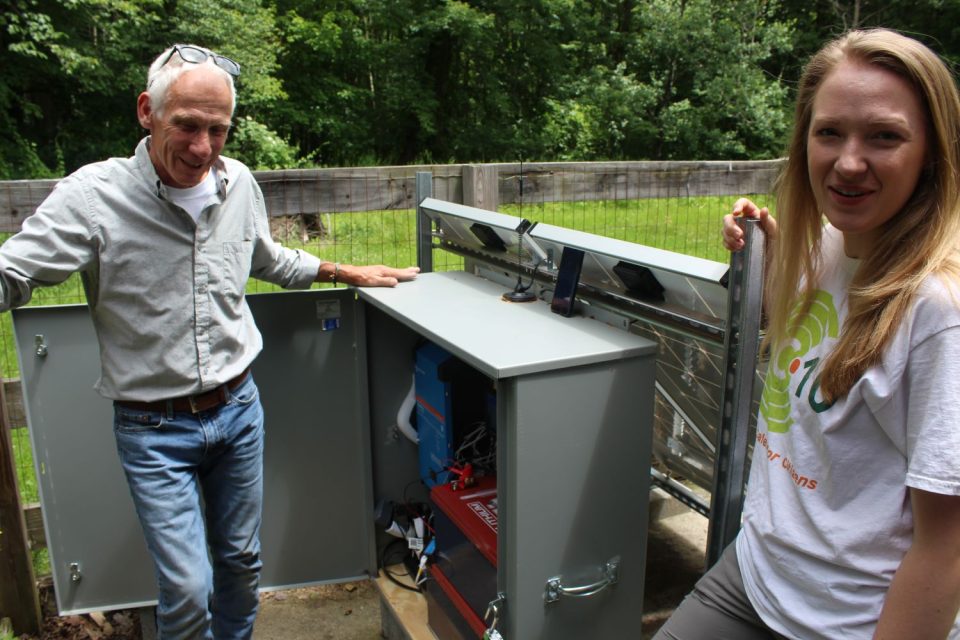REGIONAL – The watchdog organization that continuously monitors radiation leakage from the Seabrook nuclear plant has expanded and continues to harden its monitoring sites against the effects of climate change.
The C-10 Research and Education Foundation is also planning a new site on New Hampshire’s Star Island this fall, which “will give us unprecedented insights into the level and frequency of planned radiological emissions from the plant when the winds are blowing east,” wrote Sarah Abramson, the C-10 executive director.
C-10 just completed two new site installations in Massachusetts, one in the town of Merrimac included climate change resilience upgrades.
The non-profit group’s Citizens Radiological Monitoring Network (CRMN) program was developed in 1991, when the Seabrook Station nuclear power plant first became operational.
C-10 is the only citizens group in the country to operate such a network surrounding a commercial atomic reactor.
“Offsite minute-to-minute monitoring is done by C-10 because Seabrook Station does not have continuous, real-time monitoring of plant emissions beyond the plant perimeter or anywhere in the populated area around the plant,” Abramson wrote.
Beta and gamma radiation, along with wind speed and direction, are recorded continually at 19 remote sites within a 10-mile radius of the plant plus a control site in Somerville. The data is sent to the C-10 headquarters in Amesbury, where it is compiled and graphed, and monthly reports are submitted to the Massachusetts Department of Public Health, the contracting agency.
About 180,000 residents live within the 10-mile evacuation zone that covers 11 New Hampshire communities and six Massachusetts cities and towns.
Last year, C-10 began making its network resilient to prevent having the power knocked out by severe weather. It uses solar panels, batteries and cellular communications at six monitoring sites to ensure that the monitoring never stops.
“We’re excited to be developing the next generation monitoring stations,” Abramson wrote. “They will be resilient, affordable and continue to allow us to collect wind speed and direction as well as airborne beta and gamma radiation levels.”
“Our newest upgrades feature Raspberry Pi Model 3 computer with a compact hard case that will protect it from dust, and (provide) a good quality power supply. It will use GeigerLink to facilitate collection of data and a serial-to-USB converter for the RM Young wind probe. This will make for a compact setup that uses about 5W power maximum and can run 24 hours a day,” explained C-10’s CRMN Administrator Mike Mansir.
Watching the plant’s emissions may be most critical during heavy weather events, C-10 said, because “extended power outages may occur while weather is also a stressor on the Seabrook plant which suffers from degraded concrete.”
Seabrook Station, a 33-year-old pressurized water reactor, routinely releases large amounts of radioisotopes.
C-10’s data helps public health officials evaluate the impact of these releases and could aid first responders in the unlikely event of an unplanned radiological release or accident.
The cost of a new CRMN site is $7,500. A hardened site costs an additional $8,000.
New sites installed in New Hampshire recently were made possible by the Citizens’ Initiative to Expand Radiological Monitoring in the state. CRMN activities in the Commonwealth are supported by a contract with the state’s Department of Health. The program receives no financial support from New Hampshire state agencies. CRMN work that takes place in the Granite State is supported by private donors and grants such as from the New Hampshire Charitable Foundation.
Nuke Plant Monitors Hardened
Tuesday June 27, 2023




